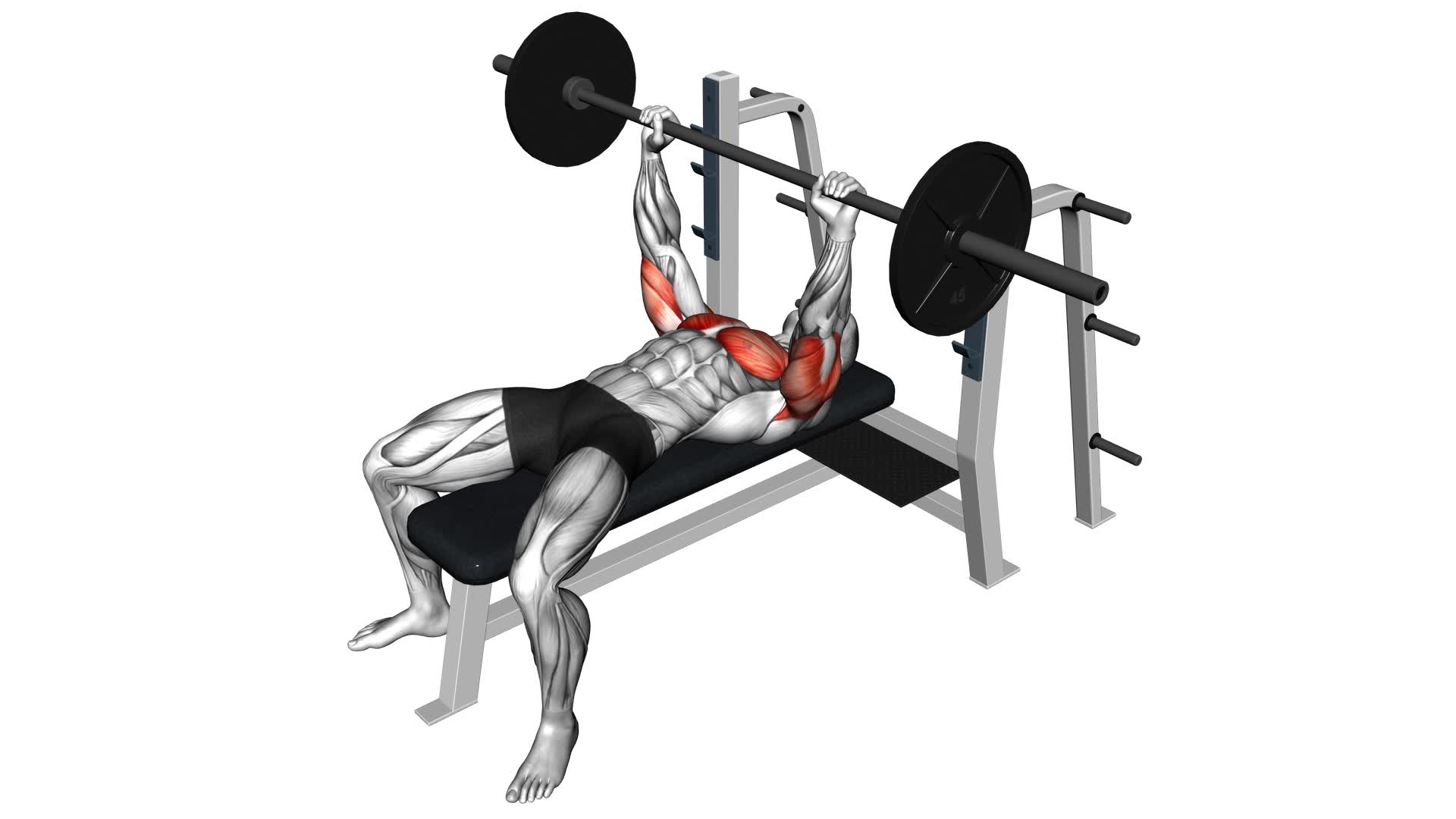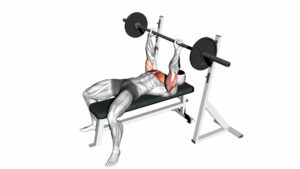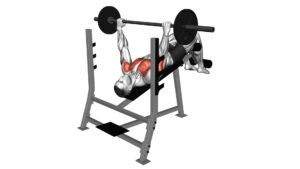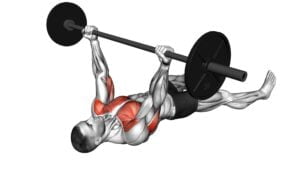Barbell Bench Press – Video Exercise Guide & Tips

Are you finding it hard to master the perfect barbell bench press technique for an effective upper body workout? It’s a common fact that this form of strength training exercise can enhance your chest muscles and overall fitness.
Watch This Exercise Video
Our comprehensive video guide, coupled with insightful tips, will provide step-by-step instructions on conducting a proper barbell bench press – from essential warm-ups to variations best suited for your level.
Ready to power up your gym routine like never before?.
Key Takeaways
- The barbell bench press builds upper body strength and targets multiple muscle groups, including the chest, shoulders, and triceps.
- Proper form and technique are essential for maximizing the benefits of the barbell bench press, such as keeping your back flat on the bench and engaging your core.
- Variations of the barbell bench press can be tailored to different fitness levels, allowing beginners to start with lighter weights and advanced individuals to incorporate pauses or resistance bands for added difficulty.
Benefits of Barbell Bench Press
The Barbell Bench Press builds upper body strength, targets multiple muscle groups, and improves overall muscle mass.
Builds upper body strength
Lifting a barbell for the bench press effectively strengthens your upper body. It focuses primarily on developing chest muscles, known as pectorals. Not just that, it also amplifies the power of other supportive muscle groups in your arms and shoulders including triceps and deltoids.
This compound exercise ensures a balanced development and increased strength across these vital areas of your upper body. It’s no surprise that fitness enthusiasts widely hailed this workout to influence their bulk up goals.
Targets multiple muscle groups
The barbell bench press is an effective exercise that targets multiple muscle groups in the upper body. When performing this exercise, you engage your chest muscles, specifically the pectoralis major and minor, which helps to build strength and increase muscle mass in your chest.
Additionally, the bench press also activates your shoulder muscles, including the deltoids, as well as your triceps and even your core muscles for stability. By incorporating the barbell bench press into your workout routine, you can efficiently work several muscle groups at once for a more comprehensive upper body workout.
Improves overall muscle mass
The barbell bench press is a highly effective exercise for improving overall muscle mass. By consistently incorporating this exercise into your workout routine, you can target multiple muscle groups in the upper body, including the chest, shoulders, and triceps.
As you progressively increase the weight and intensity of your bench press workouts, your muscles will be challenged to grow stronger and larger over time. This leads to noticeable gains in muscle mass and definition, helping you achieve a more sculpted physique.
Remember to focus on proper form and technique during each repetition to maximize the benefits of this strength training exercise.
How to Perform the Barbell Bench Press
To perform the Barbell Bench Press, start by lying flat on a bench with your feet firmly planted on the ground. Grab the barbell with an overhand grip, slightly wider than shoulder-width apart.
Lower the bar to your chest in a controlled manner, keeping your elbows at a 45-degree angle. Push the bar back up using your chest and triceps until your arms are fully extended. Repeat for the desired number of repetitions while maintaining proper form and technique throughout.
Proper form and technique
To perform the barbell bench press correctly, start by lying flat on a weightlifting bench with your feet firmly planted on the ground. Grip the barbell slightly wider than shoulder-width apart, palms facing forward.
Lower the barbell towards your chest in a controlled manner until it lightly touches your lower chest. Then, push the weight back up explosively to starting position without locking out your elbows.
Keep your core engaged and maintain a slight arch in your lower back throughout the movement for optimal form and technique.
Common mistakes to avoid
To get the most out of your barbell bench press, it’s important to avoid common mistakes that can limit your progress and increase the risk of injury. One common mistake is using improper form and technique.
It’s crucial to maintain proper body alignment and control throughout the exercise, keeping your back flat on the bench and your feet planted firmly on the ground. Another mistake to avoid is lifting too much weight without gradually increasing it over time.
This can lead to poor form and strain on your muscles. Lastly, rushing through each repetition instead of focusing on controlled movements can compromise the effectiveness of the exercise.
Variations for different fitness levels
For beginners or individuals with limited upper body strength, one variation of the barbell bench press is to start with a lighter weight. This allows you to focus on proper form and technique, gradually increasing the weight as your strength improves.
For those who are more advanced or looking for an added challenge, incorporating pauses at different points during the movement can increase the difficulty and engage your muscles even further.
Another variation is using resistance bands or chains to add variable tension throughout the exercise, providing a unique stimulus for muscle growth. No matter your fitness level, there are variations of the barbell bench press that can be tailored to help you progress towards your goals.
Tips for Maximizing Results
Maximize your results with these expert tips to take your barbell bench press to the next level.
Warm-up and cooldown techniques
Before starting your barbell bench press workout, it is important to warm up and cool down properly. This helps prepare your muscles for the intense exercise and prevent injuries. To warm up, you can do some light cardio exercises like jogging or jumping jacks to increase blood flow and loosen up your muscles.
After your workout, take a few minutes to stretch the chest, shoulders, and arms to cool down. This reduces muscle soreness and promotes flexibility. Incorporating these warm-up and cooldown techniques into your routine will optimize your barbell bench press workouts.
Proper breathing techniques
During the barbell bench press, proper breathing techniques are crucial for maximizing your performance and safety. As you lower the barbell towards your chest, inhale deeply through your nose to expand your diaphragm and fill your lungs with air.
This helps stabilize your core and create a solid base of support. As you push the barbell back up, exhale forcefully through pursed lips to engage your abdominal muscles and provide extra power to lift the weight.
Remember to maintain control throughout each repetition and avoid holding your breath, as it can increase blood pressure and decrease oxygen supply to working muscles.
Progressive overload for gains
To make consistent gains in strength and muscle mass, progressive overload is key. This technique involves gradually increasing the demands placed on your muscles over time by adding more weight, performing more repetitions, or doing more sets.
By challenging your muscles with progressively heavier loads, you force them to adapt and grow stronger. This can be achieved by adding small increments of weight each week or increasing the number of repetitions or sets in your workout routine.
Consistently pushing yourself outside of your comfort zone will ensure continuous progress and help you reach your fitness goals faster.
Complementary Exercises
Incline bench press targets the upper chest muscles and can be performed using a barbell or dumbbells.
Incline bench press
The incline bench press is a variation of the traditional barbell bench press that targets your upper chest muscles. To perform this exercise, set an incline bench to about 45 degrees and lie back with a barbell in your hands.
Lower the barbell towards your chest while keeping your elbows at a 90-degree angle, then push it back up to the starting position. This exercise helps to develop strong upper body muscles and can be beneficial for athletes looking to improve their performance in sports such as basketball or swimming.
Remember to use proper form and start with lighter weights before gradually increasing the load for maximum results.
Dumbbell bench press
When performing the dumbbell bench press, lie flat on a bench with a dumbbell in each hand. Start with your arms extended and palms facing forward. Slowly lower the dumbbells down towards your chest by bending your elbows, keeping them close to your body.
Pause for a moment at the bottom, then push the dumbbells back up to the starting position by straightening your arms. This exercise targets your chest muscles and also engages your shoulders and triceps.
It is a great alternative to the barbell bench press as it allows for greater range of motion and can help improve muscle imbalances.
To maximize results with the dumbbell bench press, focus on maintaining proper form throughout each rep. Avoid using momentum or arching your back excessively during the movement. Keep control over both phases of the exercise – lowering and raising the weights – to fully engage your target muscles.
Decline bench press
The decline bench press is a variation of the traditional bench press that targets the lower portion of your chest. To perform this exercise, lie on a decline bench with your feet secured at the top.
Hold the barbell with an overhand grip and arms extended above your chest. Lower the barbell down to your lower chest, then push it back up to starting position. This exercise helps strengthen and build muscle in your lower pectoral muscles, as well as engage your shoulder and tricep muscles for added stability and strength.
Adjusting the angle of the bench can provide different degrees of difficulty for varying fitness levels.
Conclusion
Now that you have learned the proper form and technique for the barbell bench press, as well as some tips for maximizing your results, you are ready to take your upper body workout to the next level.
Incorporating variations such as incline bench press and dumbbell bench press can help target different muscle groups and add variety to your routine. Remember to always warm up and cool down properly, use proper breathing techniques, and gradually increase the weight for progressive gains.
Keep pushing yourself and watch your chest muscles grow stronger with each workout!
FAQs
1. What is the Barbell Bench Press – Video Exercise Guide & Tips?
The Barbell Bench Press – Video Exercise Guide & Tips is a fitness resource that guides you through proper barbell bench press technique, offers weightlifting bench press advice and provides muscle building tips.
2. How does the barbell chest workout in this guide help with strength and conditioning?
This guide shows how to perform a barbell chest press correctly which can improve your strength and conditioning, particularly for your chest muscles.
3. Are there different variations of the bench press featured in this guide?
Yes, the video exercise guide includes various bench press exercises like standard weightlifting bench press and other exciting barbell bench press variations to enhance your workout routine.
4. Can beginners use this Barbell Bench Press – Video Exercise Guide & Tips?
Absolutely! This exercise guide ensures safety while providing beginner-friendly instructions for performing a proper form bench press along with fitness equipment usage details.
5. Is it possible to improve my personal best on the weight training using these tips?
Definitely! These valuable fitness tips for improving bench press strength provide techniques on increasing weight progressively while maintaining proper form ensuring progress in your muscle-building exercises.

Author
Years ago, the spark of my life’s passion ignited in my mind the moment I stepped into the local gym for the first time. The inaugural bead of perspiration, the initial endeavor, the very first surge of endorphins, and a sense of pride that washed over me post-workout marked the beginning of my deep-seated interest in strength sports, fitness, and sports nutrition. This very curiosity blossomed rapidly into a profound fascination, propelling me to earn a Master’s degree in Physical Education from the Academy of Physical Education in Krakow, followed by a Sports Manager diploma from the Jagiellonian University. My journey of growth led me to gain more specialized qualifications, such as being a certified personal trainer with a focus on sports dietetics, a lifeguard, and an instructor for wellness and corrective gymnastics. Theoretical knowledge paired seamlessly with practical experience, reinforcing my belief that the transformation of individuals under my guidance was also a reflection of my personal growth. This belief holds true even today. Each day, I strive to push the boundaries and explore new realms. These realms gently elevate me to greater heights. The unique combination of passion for my field and the continuous quest for growth fuels my drive to break new ground.







